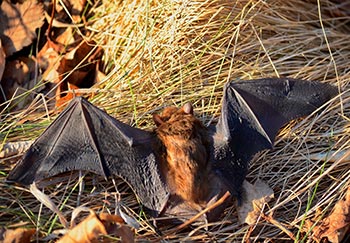
Brenda Lawson had never given too much thought to bats and rabies. Then she found herself in the middle of the night, with a bat hanging from her bedroom curtains. It was “looking really menacing and scary,” she laughs.
Lawson, who lives in Charlottesville, had noticed a moth on her bed earlier that night, when she was getting ready to go to sleep. A couple of hours later, she woke up when she felt the moth flutter across her face. She turned on the light and shooed it away. After she turned the light off, she felt something else.
“I felt this swoosh on my face and realized it was not the moth,” she recalls. She turned the light back on and saw the bat. So she yelled downstairs to her partner, who came up and, wearing heavy work gloves, knocked the bat into a glass jar with a lid.
As they looked at it, Lawson thought about how she hadn’t felt a bite. “I figured I would know if I’d been bitten,” she says. “And so we let it go.”
The following day, Lawson, a clinical microbiologist in the Medical Center’s labs, told her co-workers about the bat. One person suggested she contact the health department. “Everybody was just like, ‘Oh come on, that’s ridiculous,’” Lawson recalls.
What Does a Bat Bite Look Like?
Later that day, Lawson’s associate director, an infectious disease doctor, confirmed the health department recommendation. That was when Lawson learned that bats have tiny teeth, and their bites and scratches don’t always leave a noticeable mark. For this reason, the Centers for Disease Control and Prevention recommends seeking medical treatment in situations where a person is unsure if they’ve been bitten.
Rabies Treatment After a Bat Exposure
As of September 30, 2019, the Virginia Department of Health (VDH) has confirmed 17 cases of rabies in bats this year. The VDH typically only tests animals if there’s possible human exposure, notes Julia Murphy, state public health veterinarian with the VDH’s Office of Epidemiology. With bats, that exposure usually occurs in the home, and it happens year-round.
“We tend to see bat submissions increase in warmer weather,” Murphy says. “This is likely due, in part, to the big brown bat, a very common bat in Virginia that tends to use man-made structures for their nursery colonies and have young starting in late May through early June. This increased testing tends to then correlate with increased laboratory confirmations of bats with rabies.”
Lawson’s bat may not have had rabies, and it may not have bitten or scratched her. But UVA infectious disease expert Tania Thomas, MD, says you shouldn’t take chances with this disease. By the time you have rabies symptoms, it’s too late.
“The consequences of true transmission are dire,” she says. “It’s fatal. That’s why any bat encounter should be taken seriously.”
Rabies causes 60,000 human deaths every year; only about two usually happen in the U.S. But the majority of those U.S. rabies deaths, Thomas notes, result from bat encounters. Annually, another 55,000 people in the U.S. seek rabies postexposure prophylaxis (PEP) treatment, which prevents the disease from developing.
What should you do if you find a bat in your house?
Thomas recommends:
- Wash any obvious bites or scratches with soap and water to get the bat’s saliva out.
- Catch the bat if you can safely do so.
- Contact your local health department. In Virginia, the health department can test the bat for rabies.
- Contact your primary care doctor, who can advise you on next steps.
If you’ve been bitten or scratched, or you’re unsure — for example, you know the bat was in your house while you were sleeping — your doctor will very likely advise you to seek rabies PEP treatment as soon as possible. That involves:
- A dose of rabies immune globulin, which doctors inject directly into the wound if it’s visible
- Four doses of the rabies vaccine, administered over a two-week period
You’ll have to go to an emergency room for the first rabies vaccine and the immune globulin, Thomas says. Even if you submitted the bat to the health department for testing, you shouldn’t wait for those results before seeking treatment. If they do come back negative, though, you can stop getting the rabies vaccines.
Lawson’s Rabies Vaccine Experience
After her bat encounter, Lawson considered her options for a few days. “I thought, ‘I’m fine, probably nothing happened,’ but then I’m sure I would drive myself crazy with every little tingle or headache. Any kind of symptom, I’d think ‘This is it.’ And once you start having symptoms, you’re dead.”
Bat Encounter?
Start by talking to your primary care provider. You may need to start rabies PEP treatment at your nearest emergency room. Get info & directions for the UVA Emergency Department.
Finally, she decided to seek rabies PEP treatment at the UVA emergency room. By then, it was the Friday before Memorial Day weekend. Her second dose of the rabies vaccine was due on Monday, and since the health department was closed, she had to go back to the ER. Overall, Lawson says, this bat incident caused a lot of expense and pain (the shots hurt).
But Lawson views the experience as an opportunity for education. Of her 15 co-workers, only one realized how dangerous her bat encounter could be. So Lawson wants to raise awareness about the risks with bat encounters. This includes spreading the word about testing.
“I want people to catch the bat if they can and have it tested,” she says.


White being cautious is always safe, I wish this article had also shared more facts. Bats in Virginia eat insects, and they are valuable in controlling mosquito populations. Some bats can consume up to 3,000 insects in one night. Cave bats (Big Brown Bat and Little Brown Bat) generally give birth to only one “pup” per year. Owls, hawks, raccoons, skunks and other animals prey on bats. Bats, like any mammals, can carry rabies, but more rabies cases in Virginia are attributed to raccoons, foxes, and feral cats.
I have a question about my neighbor, who never cleans his house or yard. He has broken down vehicles around his yard, he has a jungle of over grown trees and weeds in his back yard, He also has a shed, that is pile down with junk. I had a 6 foot fence built so I could not see his mess. He has over grown trees that have destroyed my whole fence. I had a very large tree removed from my backyard today. When I was outside just before dusk, I noticed that there were a lot of bats coming out from a broken board under his roof. I don’t feel safe anymore, who can I report this to?
Annette, you probably could start with contacting your local health department.
I agree with all that you said, but like the writer above, I know that bats are actually very beneficial and fewer every year, so when this was my turn, I just let the bat go and got myself vaccinated. The first round was bad, because of my weight, I have to have quite a few syringes of immunoglobulins, but the next few injections were no big deal. My 7 year old took them like a trooper as well! I think you should have made sure that in order to test the bat they euthanize the bat in order to test its brain, so one less bat to protect us from those darn mosquitoes…